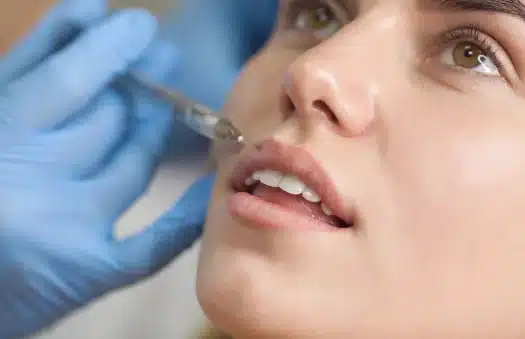Lip fillers have become incredibly popular, providing a straightforward way for people to enhance the volume and shape of their lips.
Nevertheless, achieving those perfect, plump lips involves more than just the injection itself; understanding the lip filler swelling stages is equally crucial. Both practitioners and clients must be well-informed about what happens after the fillers are administered.
Let’s find out together what to expect and how to handle each stage.
The Lip Filler Procedure
You have decided on lip fillers, but do you know the types of fillers used and the steps involved in the injection process?
The most commonly used lip fillers are based on hyaluronic acid, a substance naturally found in the body that provides hydration and volume. Hyaluronic acid dermal fillers are favored for their safety, predictability, and ease of use. Using them makes precise control over lip volume and contour possible. And their effects can be adjusted or reversed if necessary.
Other fillers, like collagen and autologous fat transfer, are less commonly used today due to the superior properties of hyaluronic acid fillers. Collagen fillers were popular in the past but have largely been replaced due to a higher risk of allergic reactions. Autologous fat transfer involves harvesting fat from another part of the body and injecting it into the lips, which is a bit more invasive and less predictable.
The procedure starts by applying topical numbing creams. Once anesthesia takes effect, the process can begin. The whole thing is typically quick, lasting around 30 minutes to an hour.
Lip Filler Swelling Stages
Immediately after the procedure, patients can expect their lips to appear swollen and possibly bruised. This is a normal reaction as the body responds to the injections. But it can last for a few days more. Here is what to expect during the first week and beyond.
Stage 1: The First 24 Hours
Swelling is typically at its peak in the first 24 hours after the procedure. We all have different bodies and immune systems, so for some, this swelling will be very noticeable, and for others, it will be mild. It will also affect the degree of discomfort.
To manage this initial swelling, follow these lip filler aftercare tips:
- Apply cold compresses intermittently throughout the day.
- Avoid consuming hot beverages.
- Refrain from engaging in vigorous physical activity.
- Take over-the-counter pain relief medications if your doctor approves them.
Stage 2: Days 2-3
Don’t worry if you notice that the swelling increases and reaches its maximum extent during days 2 to 3. This is rather normal since this heightened swelling is a natural part of the body’s inflammatory response to the filler.
Of course, that’s normal only if you don’t have a fever or related symptoms. Otherwise, it can be a sign of a problem requiring medical attention. It is essential to recognize signs of abnormal swelling or complications.
During this period:
- Lips may feel particularly tender.
- Bruising could become more visible.
- Continue applying cold compresses as needed.
- Follow additional care instructions from your practitioner.
- Elevate your head while sleeping to help reduce swelling.
Stage 3: Days 4-7
From days 4 to 7, things are usually better and better. You are starting to make a significant transition in the recovery process, and the swelling starts to subside.
During this period, you will likely notice that the initial puffiness and any significant bruising begin to diminish, revealing a more natural appearance of your lips.
Continue with the following:
- Maintain proper hydration.
- Eat healthy food to support the healing process.
- If your practitioner recommends, gently massage the lips to distribute the filler evenly.
The discomfort from the earlier stages will also decrease. If progress is slower than expected but still visible, you are on the right path, so be patient. On the other hand, if the situation remains the same or even worsens, these are warning signs that you must not ignore. An infection is probably developing and needs to be treated.
Stage 4: Day 8 and Beyond
By day 8 and beyond, you should notice a significant reduction in swelling, gradually revealing the final shape and volume of your enhanced lips. In most patients, after one week, any noticeable side effects will be minimal.
However, minor residual swelling may persist, gradually diminishing over time. To maintain your results:
- Continue doing long-term care and maintenance.
- Avoid excessive sun exposure.
- Use suitable lip care products.
That way, you will preserve the filler’s longevity and ensure your lips remain beautifully enhanced for as long as possible without frequent check-ups.
Conclusion
Knowing how your lips will swell after getting fillers is essential for a smooth recovery and getting the results you want.
It’s also important to be aware of what’s normal in terms of swelling and what might require attention from your practitioner.
By doing proper aftercare, such as using cold compresses and avoiding certain activities, you will manage swelling effectively. Enjoy your new look!
Frequently Asked Questions (FAQ)
How does the body metabolize lip fillers over time?
The body metabolizes lip fillers gradually by breaking down the hyaluronic acid through natural enzymatic processes. This process varies among individuals but generally results in the filler dissolving over six to twelve months, depending on the type of filler used and individual metabolic rate.
How does the type of filler used affect the swelling stages?
The type of filler used can influence the degree and duration of swelling. Hyaluronic acid fillers generally cause moderate swelling that subsides within a few days, while other fillers might lead to different swelling patterns based on their composition and longevity.
Can certain foods or drinks exacerbate swelling following lip filler injections?
Many foods and drinks, especially those high in sodium, alcohol, and caffeine, can exacerbate swelling following lip filler injections. These substances can lead to water retention and increased inflammation. Spicy food is also not helpful.
What are the signs that swelling after lip fillers might be indicative of an allergic reaction?
Severe and persistent swelling, intense pain, itching, redness, and the presence of hives are signs of allergy. If these symptoms occur, it is essential to seek immediate medical attention.
Are there any pre-treatment steps that can be taken to reduce the likelihood of significant swelling?
If you avoid blood-thinning medications and supplements, refrain from alcohol consumption, and stay hydrated, your chances of avoiding significant swelling are much better.
References
Kastritsi O, Kastritsi ED, Matzakanis G. Delayed hypersensitivity reaction following lip fillers, not one but four times in the same patient. JPRAS Open. 2023 Jul 17;37:130-134. doi: 10.1016/j.jpra.2023.07.003. PMID: 37534282; PMCID: PMC10393583.



0 Comments